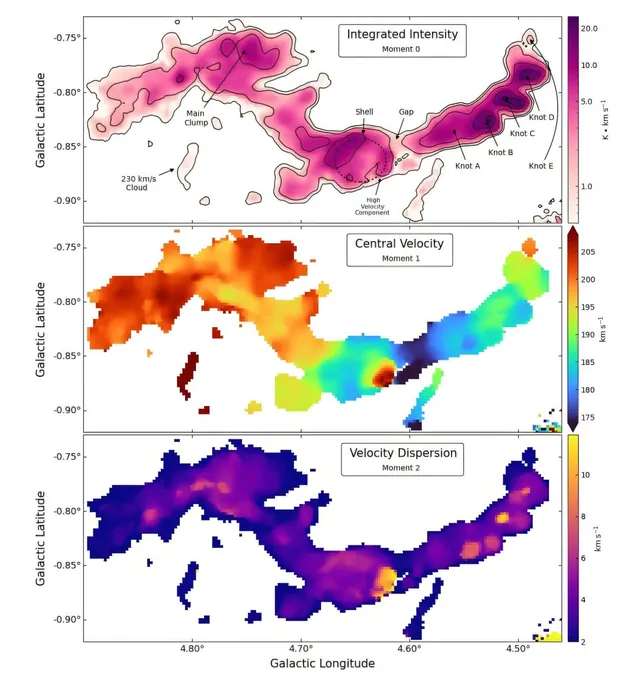
Groundbreaking Discovery! Astronomers Unveil a Massive New Molecular Cloud in the Milky Way
2025-03-24
Author: Ming
In a stunning revelation that could reshape our understanding of galactic formation and evolution, astronomers using the Green Bank Telescope (GBT) have detected an extraordinary giant molecular cloud (GMC) in the Milky Way galaxy. This newly identified cloud, designated M4.7-0.8, sprawls nearly 200 light years across and boasts a staggering mass of approximately 160,000 solar masses.
The discovery, detailed in a paper available on the arXiv preprint server, highlights the importance of these colossal clouds, which are composed primarily of molecular hydrogen. Molecular clouds are remnants from the genesis of galaxies, serving as gas reserves where the majority of star formation occurs. Understanding the lifecycle of GMCs is vital, as they play a key role in the birth and development of stars and galaxies.
Led by astronomer Natalie O. Butterfield from the National Radio Astronomy Observatory (NRAO), the team pinpointed this massive cloud at the midpoint of a dust lane within the Milky Way’s bar, located about 23,000 light years away from Earth. The findings indicate that the dust lanes of the Galactic bar are crucial conduits that transport material toward the galaxy's center, nurturing the formation of dense structures where intense star formation takes place.
“The detection of the giant molecular cloud M4.7-0.8 marks a significant milestone in our exploration of the Milky Way. Our radio observations reveal dense gas that is feeding into the Galactic center,” the researchers conveyed in their publication.
With a remarkable length of roughly 195 light years in Galactic longitude and a vertical extent of about 65 light years in Galactic latitude, M4.7-0.8 operates at a chilly dust temperature of approximately 20 K. The astronomers identified two key features within the cloud: the “Nexus,” which coincides with the brightest carbon monoxide (CO) emissions and serves as the thermal hub of the dust continuum; and the “Filament,” a slender feature exhibiting filamentary morphology that extends from the Nexus.
Excitingly, the research has also identified two distinct potential sites for star formation: Knot B and Knot E. Knot E, characterized by a dense, comet-like structure, may represent a rare free-floating evaporating gas globule, though further examination is necessary.
In addition, the M4.7-0.8 cloud harbors a shell-like structure, exhibiting a brighter rim in ammonia emissions while displaying a cavity at its core. These findings not only deepen our comprehension of molecular clouds but also offer tantalizing clues about the processes at play in the heart of our galaxy.
Stay tuned as scientists continue to unravel the mysteries surrounding M4.7-0.8, potentially unlocking new insights into the intricate tapestry of star formation and galactic dynamics!


 Brasil (PT)
Brasil (PT)
 Canada (EN)
Canada (EN)
 Chile (ES)
Chile (ES)
 Česko (CS)
Česko (CS)
 대한민국 (KO)
대한민국 (KO)
 España (ES)
España (ES)
 France (FR)
France (FR)
 Hong Kong (EN)
Hong Kong (EN)
 Italia (IT)
Italia (IT)
 日本 (JA)
日本 (JA)
 Magyarország (HU)
Magyarország (HU)
 Norge (NO)
Norge (NO)
 Polska (PL)
Polska (PL)
 Schweiz (DE)
Schweiz (DE)
 Singapore (EN)
Singapore (EN)
 Sverige (SV)
Sverige (SV)
 Suomi (FI)
Suomi (FI)
 Türkiye (TR)
Türkiye (TR)
 الإمارات العربية المتحدة (AR)
الإمارات العربية المتحدة (AR)